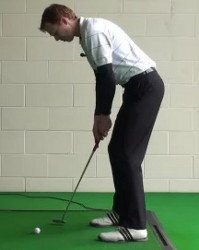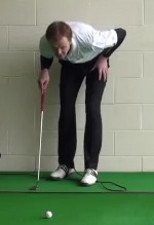
After Greens in Regulation, the most telling stat on the PGA Tour might be Strokes Gained Putting. As proof, consider that the category leader for both 2010 and 2011 was Luke Donald, who just happened to climb to No. 1 in the world during that period.
Basically, Strokes Gained Putting tells us how a particular player fares against the field in number of putts taken. Tour pros are so uniformly proficient from tee to green, he who putts best nearly always contends, and often wins.
Putting is such a subtle art that one must pay close attention to learn what makes professionals so good at it. Once you know what to watch for, you can gain genuine stroke-saving insight. In Part I of this feature, we’ll examine how pros prepare for each putt.
Why It’s Important
 It’s common knowledge that about 40 percent of a golfer’s total strokes occur on the putting green, regardless of handicap. While tap-ins account for a fair portion of that, there’s no denying the prominent role putting plays in how you score.
It’s common knowledge that about 40 percent of a golfer’s total strokes occur on the putting green, regardless of handicap. While tap-ins account for a fair portion of that, there’s no denying the prominent role putting plays in how you score.
The key elements of any putt are line and speed. Pros, of course, are experts at gauging how a putt will break (curve) and the pace at which it will roll. While it’s important to learn the fundamentals of green-reading, putting ultimately comes down to feel.
That said, it’s critical to have an effective pre-shot routine on the greens. Your setup and tempo will be more consistent and you’ll be able to block out distracting thoughts.
A quick word about pace of play: Pros spend a lot of time reading the break of their putts from several angles. For most amateurs, a look from behind the ball toward the hole is sufficient on all but the trickiest breakers. Unless you’re first to play in your group, always read your putt while others are preparing and hitting theirs. That way you’ll be ready when it’s your turn.
Who You Should Watch
Tiger Woods employs a model pre-shot routine on full shots, and he’s equally efficient with putter in hand. Once he’s determined the line and speed, Tiger aims his ball’s alignment aid (a line or arrow, depending on the brand) where he wants the putt to start. Next he takes a stance behind the ball and directly on his chosen, making a couple of practice strokes that mimic the stroke he wants to put on the ball.

Tiger then assumes his setup position over the ball, takes two glances at the hole and back to the ball, focuses and strokes it. And he does it the exact same way every single time.
Most of Woods’ peers use a version of this process.
There’s one piece of a good pre-shot routine that can’t be seen from the outside: visualization. Woods and Co. always picture the ball going into the hole before taking the blade back. You should, too.
Apply It to Your Game
Like the pre-shot routine for a wood, hybrid or iron, your pre-putt sequence should include a few basic parts:
- Read the green from behind the ball, and from the other side if time permits.
- Pick a target. If the putt is straight, aim at the hole. On a breaking putt, choose a spot at the high point of the line (i.e. where it will begin turning toward the cup).
- Align the ball at the target using the guide printed on the ball.
- Once you’ve addressed the ball, take a look or two at the hole.
- In your mind’s eye, picture the ball rolling into center of the cup.
Q: What are some essential golf putting tips for improving putting performance? A: Some essential golf putting tips include maintaining a relaxed grip, keeping the head steady during the stroke, focusing on a smooth and rhythmic pendulum motion, and practicing distance control.
Q: How can golfers improve their putting alignment and aim? A: Golfers can improve their putting alignment and aim by using a consistent pre-putt routine, aligning the putter face square to the target line, and using an intermediate target to aid in alignment.
Q: What role does visualization play in improving putting performance? A: Visualization is crucial in putting as it helps golfers see the intended line and imagine the ball rolling into the hole. By visualizing a successful putt, golfers can build confidence and increase their chances of holing the putt.
Q: How can golfers develop a consistent putting stroke? A: Developing a consistent putting stroke involves regular practice and maintaining a smooth and even tempo. Golfers can use putting drills and practice routines to refine their stroke mechanics and build muscle memory.
Q: What are some effective drills for practicing putting? A: Some effective putting drills include the “gate drill” using tees to create a gate for the putter to pass through, the “around the clock” drill for distance control, and the “Ladder Drill” to work on varying lengths of putts.
Q: Should golfers focus more on speed or line when putting? A: Both speed and line are essential in putting. Golfers should focus on finding the right pace to give the ball a chance to go in the hole while also ensuring the correct line for the putt.
Q: How can golfers improve their short putting, especially for three-foot putts? A: Short putting can be improved through consistent practice and building confidence. Golfers should work on their short putts during practice sessions and develop a routine for three-foot putts to increase their success rate.
Q: How can golfers read greens effectively to determine the break and slope? A: Reading greens effectively involves carefully observing the slope and the grain of the grass. Golfers can walk around the hole, crouch down to view the contours, and use their feet to feel the slopes.
Q: What is the importance of a solid mental approach to putting? A: A solid mental approach is vital in putting as it helps golfers stay focused, positive, and committed to their stroke. Confidence, concentration, and managing nerves are all essential aspects of a successful putting mindset.
Q: How can golfers handle pressure and maintain composure during important putts? A: Handling pressure during important putts requires staying in the present moment and not letting past or future outcomes influence the stroke. Deep breathing, visualizing a successful putt, and sticking to the routine can help maintain composure under pressure.
Q: Can golfers use putting aids or training tools to improve their putting skills? A: Yes, putting aids and training tools can be beneficial in improving putting skills. Devices like putting mirrors, alignment aids, and putting mats can provide feedback and help golfers work on specific aspects of their putting stroke.
Q: Is it beneficial for golfers to seek professional instruction for their putting technique? A: Yes, seeking professional instruction can be highly beneficial for golfers looking to improve their putting technique. A putting coach or instructor can analyze the golfer's stroke, provide personalized feedback, and offer drills to address specific areas of improvement.
Part II of this feature discusses how the pros proceed once they’re ready to putt.






